Civil Engineering Technology Report: Construction Analysis
VerifiedAdded on 2022/08/18
|11
|3021
|17
Report
AI Summary
This report presents a comprehensive analysis of civil engineering technologies applied to the construction of an industrial park. It begins with the estimation of earthwork, detailing assumptions, calculations, and equipment used for surveying, excavation, and foundation laying. The report then explores methods and techniques for culvert and underpass construction, addressing challenges like water management and the use of coffer dams and sheet pile walls. It also covers earth moving operations, slope stability analysis, and risk assessments, including safety plans for various construction phases. Furthermore, the report examines health and safety legislation, environmental, geotechnical, and economic contexts, and proposes solutions to address these challenges. Finally, it addresses methods and techniques utilized in highway design and construction of flexible pavements. The report provides a detailed overview of the construction process from start to finish.
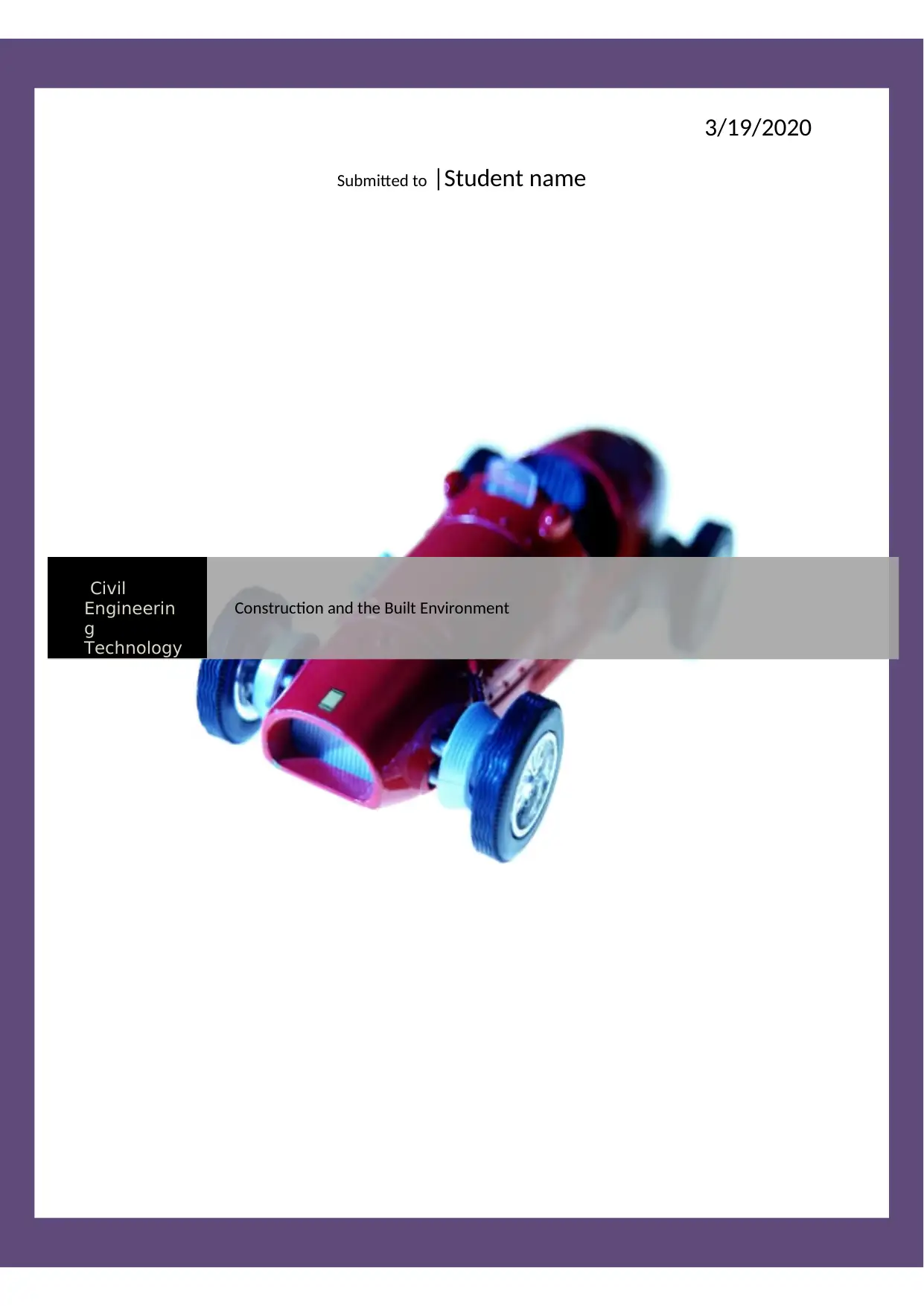
3/19/2020
Submitted to |Student name
Civil
Engineerin
g
Technology
Construction and the Built Environment
Submitted to |Student name
Civil
Engineerin
g
Technology
Construction and the Built Environment
Paraphrase This Document
Need a fresh take? Get an instant paraphrase of this document with our AI Paraphraser
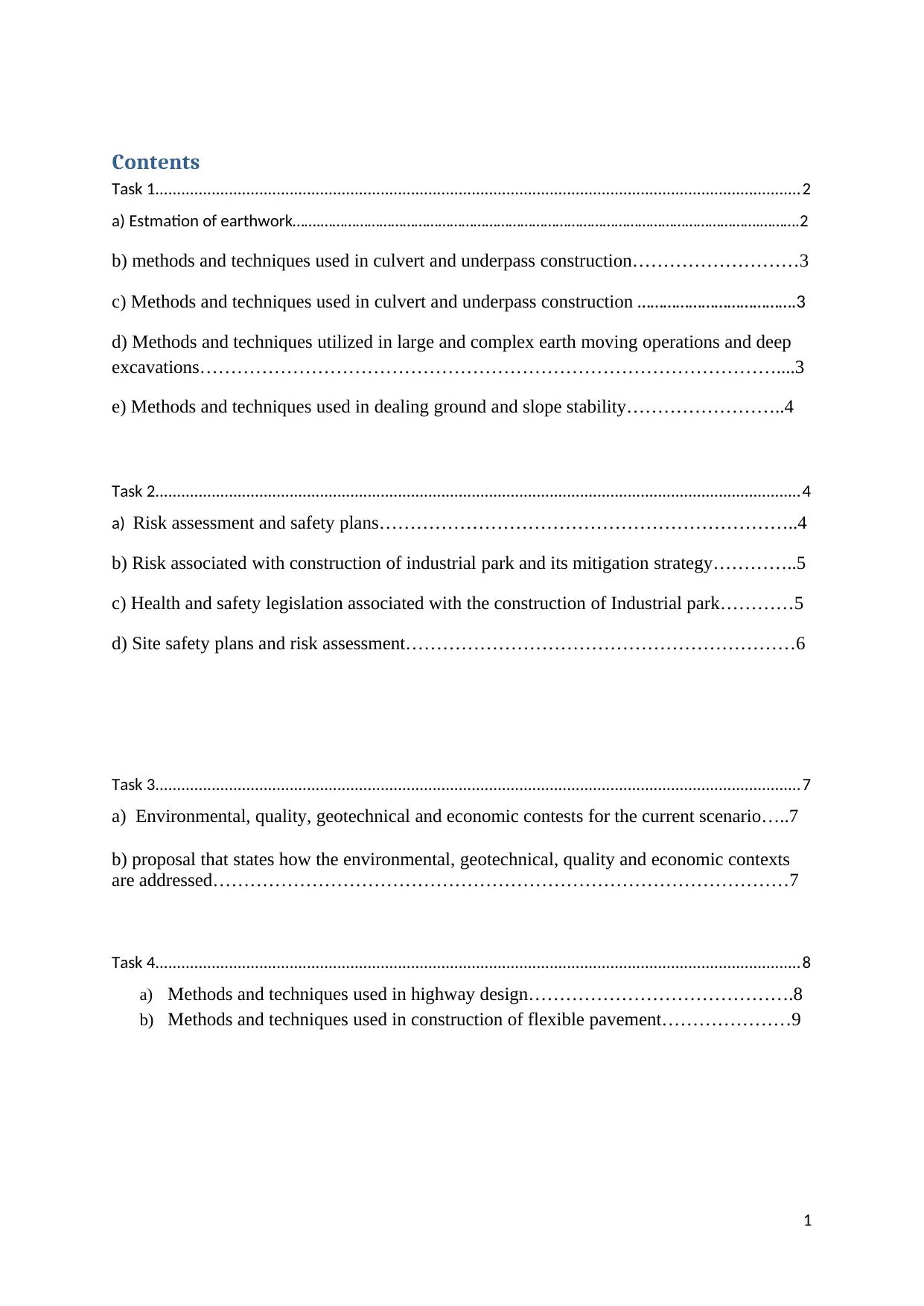
Contents
Task 1.....................................................................................................................................................2
a) Estmation of earthwork…….………………………………………………………………………………………………….……….2
b) methods and techniques used in culvert and underpass construction………………………3
c) Methods and techniques used in culvert and underpass construction ……………………………….3
d) Methods and techniques utilized in large and complex earth moving operations and deep
excavations…………………………………………………………………………………....3
e) Methods and techniques used in dealing ground and slope stability……………………..4
Task 2.....................................................................................................................................................4
a) Risk assessment and safety plans…………………………………………………………..4
b) Risk associated with construction of industrial park and its mitigation strategy…………..5
c) Health and safety legislation associated with the construction of Industrial park…………5
d) Site safety plans and risk assessment………………………………………………………6
Task 3.....................................................................................................................................................7
a) Environmental, quality, geotechnical and economic contests for the current scenario…..7
b) proposal that states how the environmental, geotechnical, quality and economic contexts
are addressed…………………………………………………………………………………7
Task 4.....................................................................................................................................................8
a) Methods and techniques used in highway design…………………………………….8
b) Methods and techniques used in construction of flexible pavement…………………9
1
Task 1.....................................................................................................................................................2
a) Estmation of earthwork…….………………………………………………………………………………………………….……….2
b) methods and techniques used in culvert and underpass construction………………………3
c) Methods and techniques used in culvert and underpass construction ……………………………….3
d) Methods and techniques utilized in large and complex earth moving operations and deep
excavations…………………………………………………………………………………....3
e) Methods and techniques used in dealing ground and slope stability……………………..4
Task 2.....................................................................................................................................................4
a) Risk assessment and safety plans…………………………………………………………..4
b) Risk associated with construction of industrial park and its mitigation strategy…………..5
c) Health and safety legislation associated with the construction of Industrial park…………5
d) Site safety plans and risk assessment………………………………………………………6
Task 3.....................................................................................................................................................7
a) Environmental, quality, geotechnical and economic contests for the current scenario…..7
b) proposal that states how the environmental, geotechnical, quality and economic contexts
are addressed…………………………………………………………………………………7
Task 4.....................................................................................................................................................8
a) Methods and techniques used in highway design…………………………………….8
b) Methods and techniques used in construction of flexible pavement…………………9
1
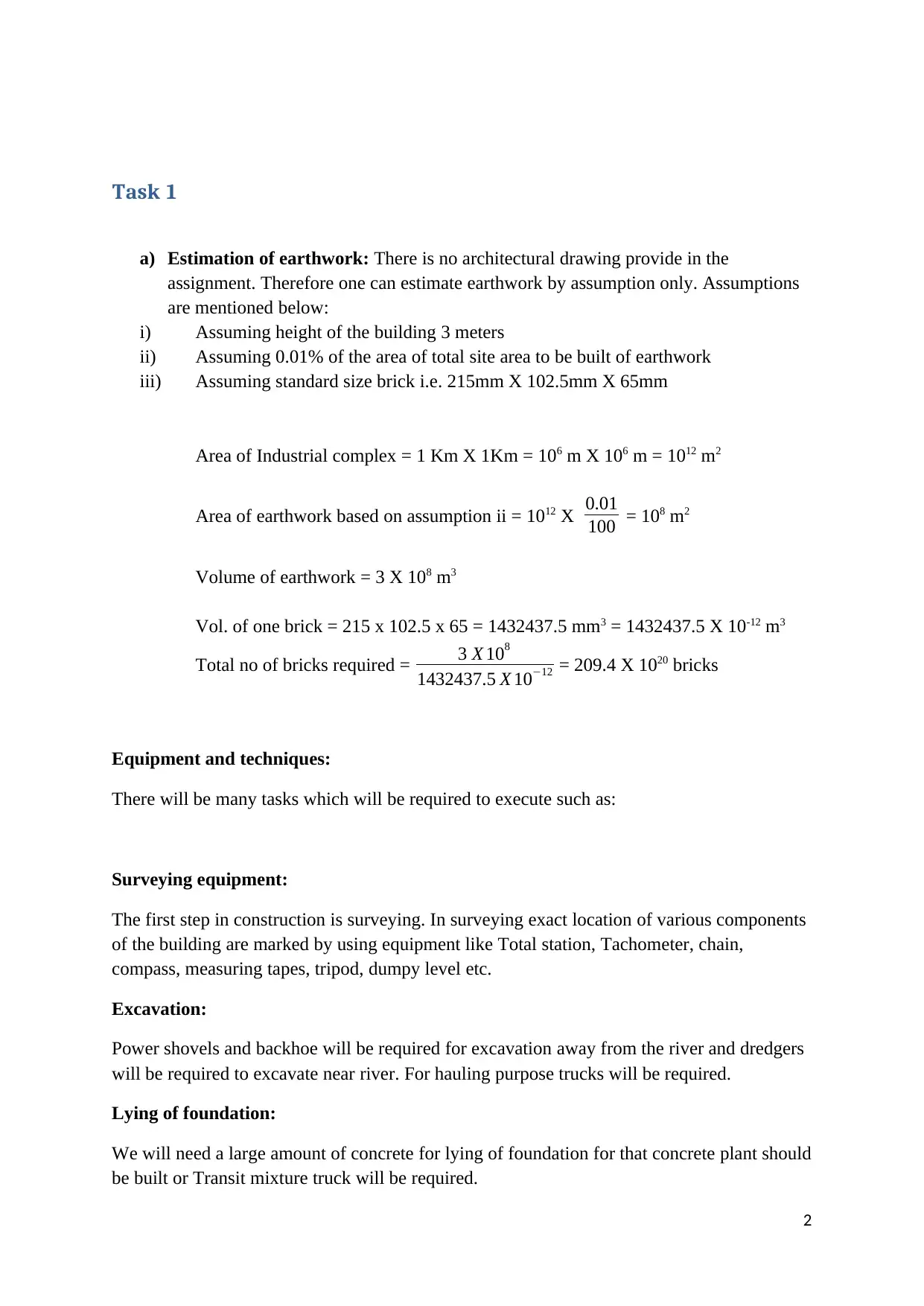
Task 1
a) Estimation of earthwork: There is no architectural drawing provide in the
assignment. Therefore one can estimate earthwork by assumption only. Assumptions
are mentioned below:
i) Assuming height of the building 3 meters
ii) Assuming 0.01% of the area of total site area to be built of earthwork
iii) Assuming standard size brick i.e. 215mm X 102.5mm X 65mm
Area of Industrial complex = 1 Km X 1Km = 106 m X 106 m = 1012 m2
Area of earthwork based on assumption ii = 1012 X 0.01
100 = 108 m2
Volume of earthwork = 3 X 108 m3
Vol. of one brick = 215 x 102.5 x 65 = 1432437.5 mm3 = 1432437.5 X 10-12 m3
Total no of bricks required = 3 X 108
1432437.5 X 10−12 = 209.4 X 1020 bricks
Equipment and techniques:
There will be many tasks which will be required to execute such as:
Surveying equipment:
The first step in construction is surveying. In surveying exact location of various components
of the building are marked by using equipment like Total station, Tachometer, chain,
compass, measuring tapes, tripod, dumpy level etc.
Excavation:
Power shovels and backhoe will be required for excavation away from the river and dredgers
will be required to excavate near river. For hauling purpose trucks will be required.
Lying of foundation:
We will need a large amount of concrete for lying of foundation for that concrete plant should
be built or Transit mixture truck will be required.
2
a) Estimation of earthwork: There is no architectural drawing provide in the
assignment. Therefore one can estimate earthwork by assumption only. Assumptions
are mentioned below:
i) Assuming height of the building 3 meters
ii) Assuming 0.01% of the area of total site area to be built of earthwork
iii) Assuming standard size brick i.e. 215mm X 102.5mm X 65mm
Area of Industrial complex = 1 Km X 1Km = 106 m X 106 m = 1012 m2
Area of earthwork based on assumption ii = 1012 X 0.01
100 = 108 m2
Volume of earthwork = 3 X 108 m3
Vol. of one brick = 215 x 102.5 x 65 = 1432437.5 mm3 = 1432437.5 X 10-12 m3
Total no of bricks required = 3 X 108
1432437.5 X 10−12 = 209.4 X 1020 bricks
Equipment and techniques:
There will be many tasks which will be required to execute such as:
Surveying equipment:
The first step in construction is surveying. In surveying exact location of various components
of the building are marked by using equipment like Total station, Tachometer, chain,
compass, measuring tapes, tripod, dumpy level etc.
Excavation:
Power shovels and backhoe will be required for excavation away from the river and dredgers
will be required to excavate near river. For hauling purpose trucks will be required.
Lying of foundation:
We will need a large amount of concrete for lying of foundation for that concrete plant should
be built or Transit mixture truck will be required.
2
⊘ This is a preview!⊘
Do you want full access?
Subscribe today to unlock all pages.

Trusted by 1+ million students worldwide
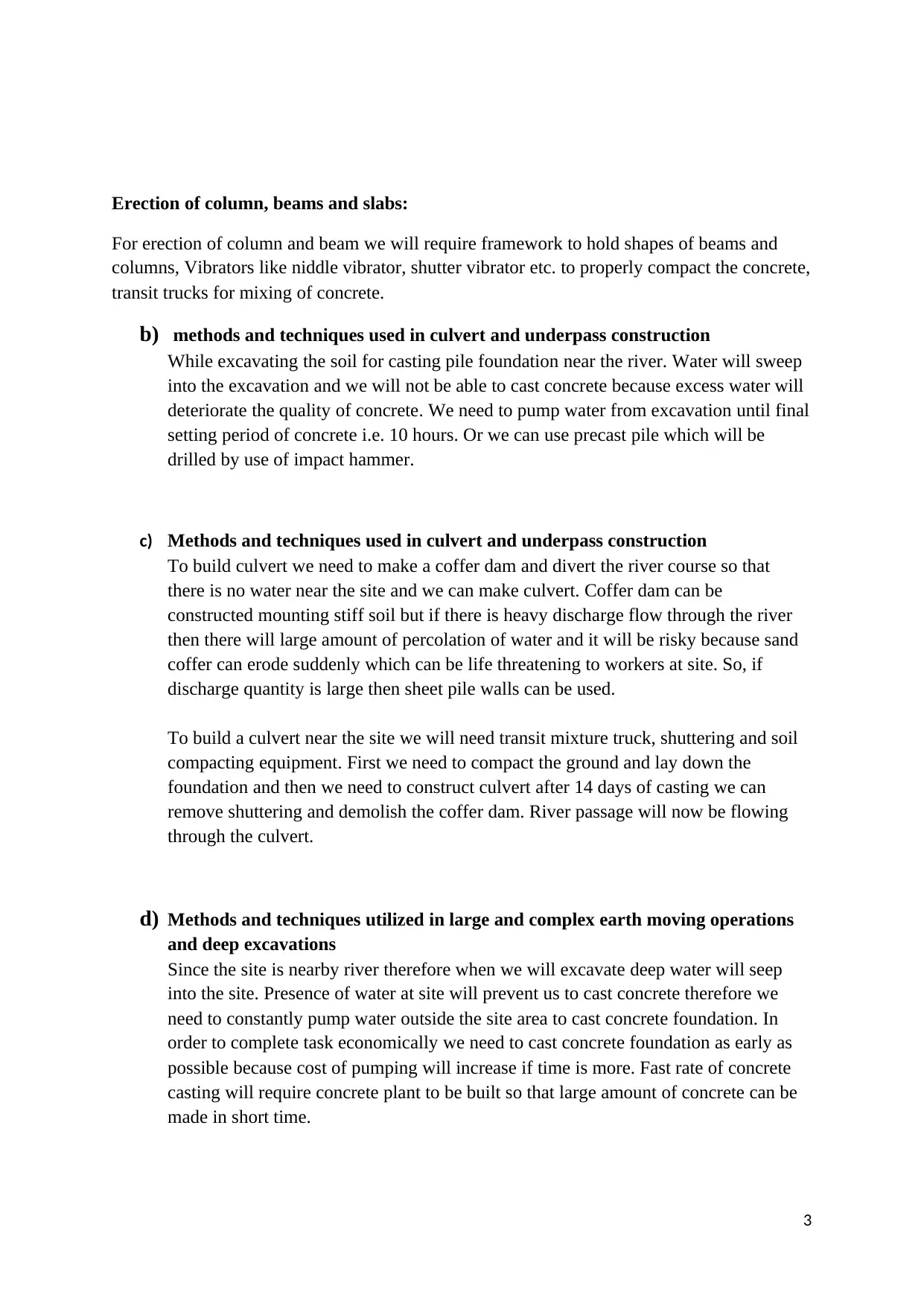
Erection of column, beams and slabs:
For erection of column and beam we will require framework to hold shapes of beams and
columns, Vibrators like niddle vibrator, shutter vibrator etc. to properly compact the concrete,
transit trucks for mixing of concrete.
b) methods and techniques used in culvert and underpass construction
While excavating the soil for casting pile foundation near the river. Water will sweep
into the excavation and we will not be able to cast concrete because excess water will
deteriorate the quality of concrete. We need to pump water from excavation until final
setting period of concrete i.e. 10 hours. Or we can use precast pile which will be
drilled by use of impact hammer.
c) Methods and techniques used in culvert and underpass construction
To build culvert we need to make a coffer dam and divert the river course so that
there is no water near the site and we can make culvert. Coffer dam can be
constructed mounting stiff soil but if there is heavy discharge flow through the river
then there will large amount of percolation of water and it will be risky because sand
coffer can erode suddenly which can be life threatening to workers at site. So, if
discharge quantity is large then sheet pile walls can be used.
To build a culvert near the site we will need transit mixture truck, shuttering and soil
compacting equipment. First we need to compact the ground and lay down the
foundation and then we need to construct culvert after 14 days of casting we can
remove shuttering and demolish the coffer dam. River passage will now be flowing
through the culvert.
d) Methods and techniques utilized in large and complex earth moving operations
and deep excavations
Since the site is nearby river therefore when we will excavate deep water will seep
into the site. Presence of water at site will prevent us to cast concrete therefore we
need to constantly pump water outside the site area to cast concrete foundation. In
order to complete task economically we need to cast concrete foundation as early as
possible because cost of pumping will increase if time is more. Fast rate of concrete
casting will require concrete plant to be built so that large amount of concrete can be
made in short time.
3
For erection of column and beam we will require framework to hold shapes of beams and
columns, Vibrators like niddle vibrator, shutter vibrator etc. to properly compact the concrete,
transit trucks for mixing of concrete.
b) methods and techniques used in culvert and underpass construction
While excavating the soil for casting pile foundation near the river. Water will sweep
into the excavation and we will not be able to cast concrete because excess water will
deteriorate the quality of concrete. We need to pump water from excavation until final
setting period of concrete i.e. 10 hours. Or we can use precast pile which will be
drilled by use of impact hammer.
c) Methods and techniques used in culvert and underpass construction
To build culvert we need to make a coffer dam and divert the river course so that
there is no water near the site and we can make culvert. Coffer dam can be
constructed mounting stiff soil but if there is heavy discharge flow through the river
then there will large amount of percolation of water and it will be risky because sand
coffer can erode suddenly which can be life threatening to workers at site. So, if
discharge quantity is large then sheet pile walls can be used.
To build a culvert near the site we will need transit mixture truck, shuttering and soil
compacting equipment. First we need to compact the ground and lay down the
foundation and then we need to construct culvert after 14 days of casting we can
remove shuttering and demolish the coffer dam. River passage will now be flowing
through the culvert.
d) Methods and techniques utilized in large and complex earth moving operations
and deep excavations
Since the site is nearby river therefore when we will excavate deep water will seep
into the site. Presence of water at site will prevent us to cast concrete therefore we
need to constantly pump water outside the site area to cast concrete foundation. In
order to complete task economically we need to cast concrete foundation as early as
possible because cost of pumping will increase if time is more. Fast rate of concrete
casting will require concrete plant to be built so that large amount of concrete can be
made in short time.
3
Paraphrase This Document
Need a fresh take? Get an instant paraphrase of this document with our AI Paraphraser
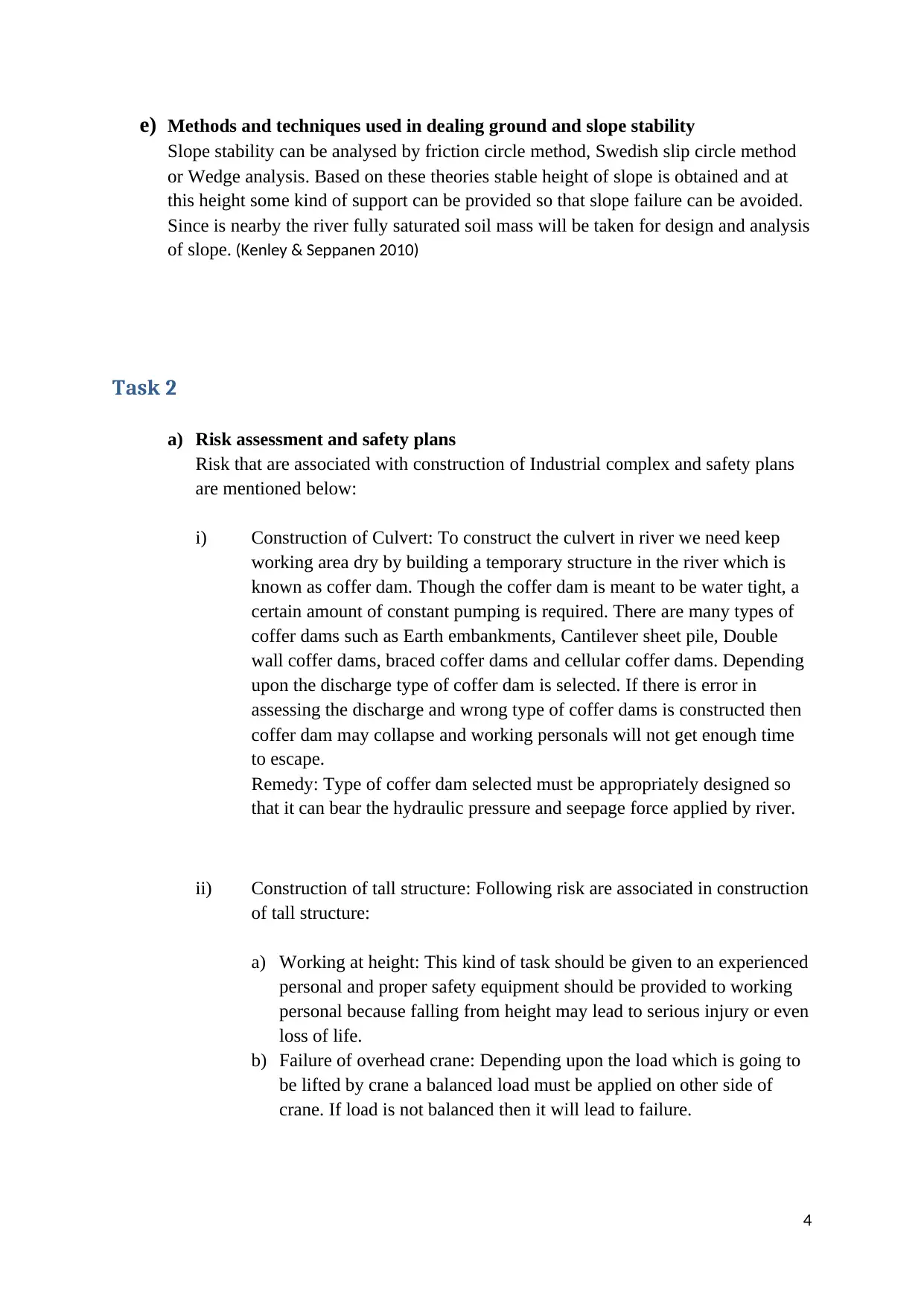
e) Methods and techniques used in dealing ground and slope stability
Slope stability can be analysed by friction circle method, Swedish slip circle method
or Wedge analysis. Based on these theories stable height of slope is obtained and at
this height some kind of support can be provided so that slope failure can be avoided.
Since is nearby the river fully saturated soil mass will be taken for design and analysis
of slope. (Kenley & Seppanen 2010)
Task 2
a) Risk assessment and safety plans
Risk that are associated with construction of Industrial complex and safety plans
are mentioned below:
i) Construction of Culvert: To construct the culvert in river we need keep
working area dry by building a temporary structure in the river which is
known as coffer dam. Though the coffer dam is meant to be water tight, a
certain amount of constant pumping is required. There are many types of
coffer dams such as Earth embankments, Cantilever sheet pile, Double
wall coffer dams, braced coffer dams and cellular coffer dams. Depending
upon the discharge type of coffer dam is selected. If there is error in
assessing the discharge and wrong type of coffer dams is constructed then
coffer dam may collapse and working personals will not get enough time
to escape.
Remedy: Type of coffer dam selected must be appropriately designed so
that it can bear the hydraulic pressure and seepage force applied by river.
ii) Construction of tall structure: Following risk are associated in construction
of tall structure:
a) Working at height: This kind of task should be given to an experienced
personal and proper safety equipment should be provided to working
personal because falling from height may lead to serious injury or even
loss of life.
b) Failure of overhead crane: Depending upon the load which is going to
be lifted by crane a balanced load must be applied on other side of
crane. If load is not balanced then it will lead to failure.
4
Slope stability can be analysed by friction circle method, Swedish slip circle method
or Wedge analysis. Based on these theories stable height of slope is obtained and at
this height some kind of support can be provided so that slope failure can be avoided.
Since is nearby the river fully saturated soil mass will be taken for design and analysis
of slope. (Kenley & Seppanen 2010)
Task 2
a) Risk assessment and safety plans
Risk that are associated with construction of Industrial complex and safety plans
are mentioned below:
i) Construction of Culvert: To construct the culvert in river we need keep
working area dry by building a temporary structure in the river which is
known as coffer dam. Though the coffer dam is meant to be water tight, a
certain amount of constant pumping is required. There are many types of
coffer dams such as Earth embankments, Cantilever sheet pile, Double
wall coffer dams, braced coffer dams and cellular coffer dams. Depending
upon the discharge type of coffer dam is selected. If there is error in
assessing the discharge and wrong type of coffer dams is constructed then
coffer dam may collapse and working personals will not get enough time
to escape.
Remedy: Type of coffer dam selected must be appropriately designed so
that it can bear the hydraulic pressure and seepage force applied by river.
ii) Construction of tall structure: Following risk are associated in construction
of tall structure:
a) Working at height: This kind of task should be given to an experienced
personal and proper safety equipment should be provided to working
personal because falling from height may lead to serious injury or even
loss of life.
b) Failure of overhead crane: Depending upon the load which is going to
be lifted by crane a balanced load must be applied on other side of
crane. If load is not balanced then it will lead to failure.
4
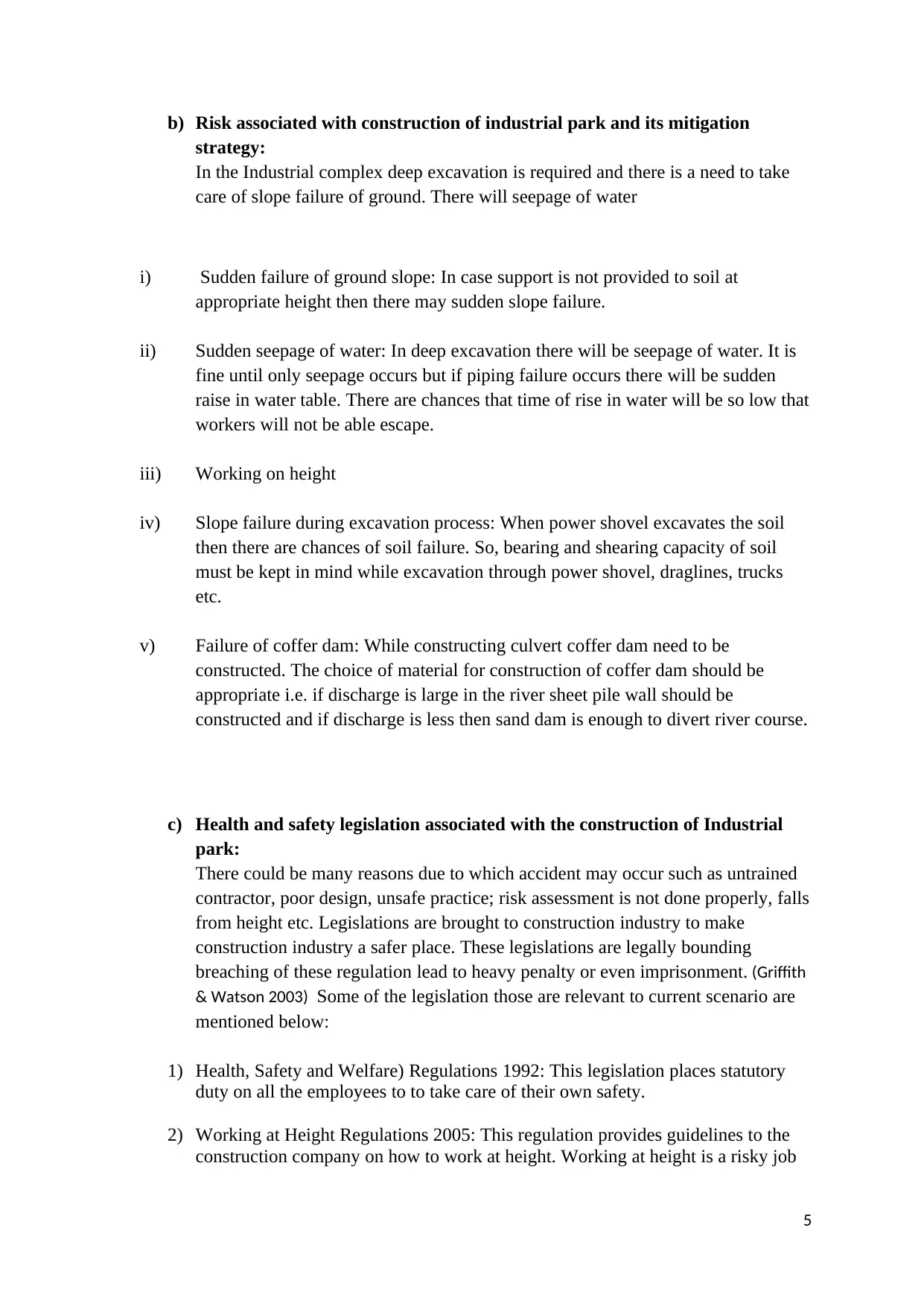
b) Risk associated with construction of industrial park and its mitigation
strategy:
In the Industrial complex deep excavation is required and there is a need to take
care of slope failure of ground. There will seepage of water
i) Sudden failure of ground slope: In case support is not provided to soil at
appropriate height then there may sudden slope failure.
ii) Sudden seepage of water: In deep excavation there will be seepage of water. It is
fine until only seepage occurs but if piping failure occurs there will be sudden
raise in water table. There are chances that time of rise in water will be so low that
workers will not be able escape.
iii) Working on height
iv) Slope failure during excavation process: When power shovel excavates the soil
then there are chances of soil failure. So, bearing and shearing capacity of soil
must be kept in mind while excavation through power shovel, draglines, trucks
etc.
v) Failure of coffer dam: While constructing culvert coffer dam need to be
constructed. The choice of material for construction of coffer dam should be
appropriate i.e. if discharge is large in the river sheet pile wall should be
constructed and if discharge is less then sand dam is enough to divert river course.
c) Health and safety legislation associated with the construction of Industrial
park:
There could be many reasons due to which accident may occur such as untrained
contractor, poor design, unsafe practice; risk assessment is not done properly, falls
from height etc. Legislations are brought to construction industry to make
construction industry a safer place. These legislations are legally bounding
breaching of these regulation lead to heavy penalty or even imprisonment. (Griffith
& Watson 2003) Some of the legislation those are relevant to current scenario are
mentioned below:
1) Health, Safety and Welfare) Regulations 1992: This legislation places statutory
duty on all the employees to to take care of their own safety.
2) Working at Height Regulations 2005: This regulation provides guidelines to the
construction company on how to work at height. Working at height is a risky job
5
strategy:
In the Industrial complex deep excavation is required and there is a need to take
care of slope failure of ground. There will seepage of water
i) Sudden failure of ground slope: In case support is not provided to soil at
appropriate height then there may sudden slope failure.
ii) Sudden seepage of water: In deep excavation there will be seepage of water. It is
fine until only seepage occurs but if piping failure occurs there will be sudden
raise in water table. There are chances that time of rise in water will be so low that
workers will not be able escape.
iii) Working on height
iv) Slope failure during excavation process: When power shovel excavates the soil
then there are chances of soil failure. So, bearing and shearing capacity of soil
must be kept in mind while excavation through power shovel, draglines, trucks
etc.
v) Failure of coffer dam: While constructing culvert coffer dam need to be
constructed. The choice of material for construction of coffer dam should be
appropriate i.e. if discharge is large in the river sheet pile wall should be
constructed and if discharge is less then sand dam is enough to divert river course.
c) Health and safety legislation associated with the construction of Industrial
park:
There could be many reasons due to which accident may occur such as untrained
contractor, poor design, unsafe practice; risk assessment is not done properly, falls
from height etc. Legislations are brought to construction industry to make
construction industry a safer place. These legislations are legally bounding
breaching of these regulation lead to heavy penalty or even imprisonment. (Griffith
& Watson 2003) Some of the legislation those are relevant to current scenario are
mentioned below:
1) Health, Safety and Welfare) Regulations 1992: This legislation places statutory
duty on all the employees to to take care of their own safety.
2) Working at Height Regulations 2005: This regulation provides guidelines to the
construction company on how to work at height. Working at height is a risky job
5
⊘ This is a preview!⊘
Do you want full access?
Subscribe today to unlock all pages.

Trusted by 1+ million students worldwide
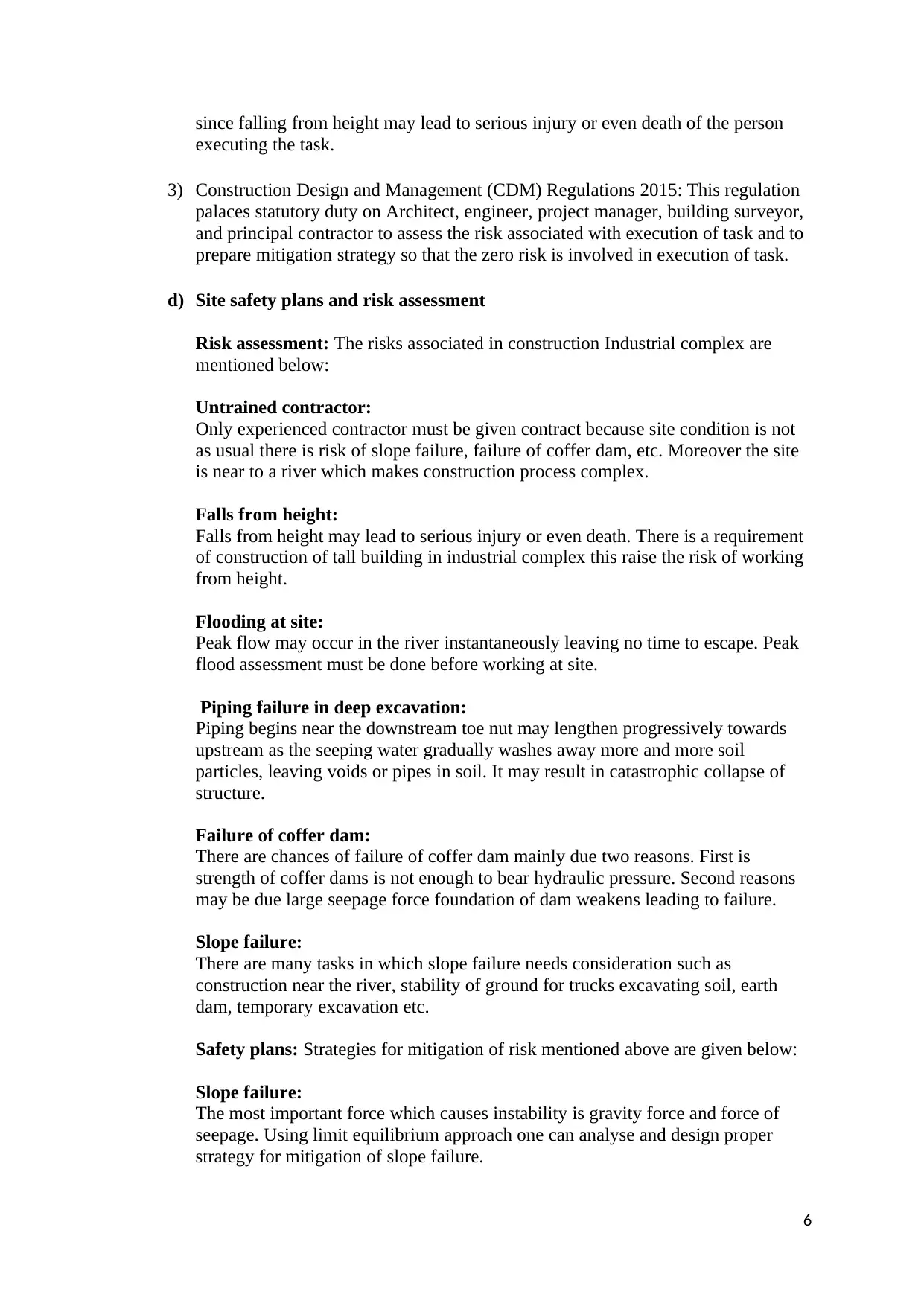
since falling from height may lead to serious injury or even death of the person
executing the task.
3) Construction Design and Management (CDM) Regulations 2015: This regulation
palaces statutory duty on Architect, engineer, project manager, building surveyor,
and principal contractor to assess the risk associated with execution of task and to
prepare mitigation strategy so that the zero risk is involved in execution of task.
d) Site safety plans and risk assessment
Risk assessment: The risks associated in construction Industrial complex are
mentioned below:
Untrained contractor:
Only experienced contractor must be given contract because site condition is not
as usual there is risk of slope failure, failure of coffer dam, etc. Moreover the site
is near to a river which makes construction process complex.
Falls from height:
Falls from height may lead to serious injury or even death. There is a requirement
of construction of tall building in industrial complex this raise the risk of working
from height.
Flooding at site:
Peak flow may occur in the river instantaneously leaving no time to escape. Peak
flood assessment must be done before working at site.
Piping failure in deep excavation:
Piping begins near the downstream toe nut may lengthen progressively towards
upstream as the seeping water gradually washes away more and more soil
particles, leaving voids or pipes in soil. It may result in catastrophic collapse of
structure.
Failure of coffer dam:
There are chances of failure of coffer dam mainly due two reasons. First is
strength of coffer dams is not enough to bear hydraulic pressure. Second reasons
may be due large seepage force foundation of dam weakens leading to failure.
Slope failure:
There are many tasks in which slope failure needs consideration such as
construction near the river, stability of ground for trucks excavating soil, earth
dam, temporary excavation etc.
Safety plans: Strategies for mitigation of risk mentioned above are given below:
Slope failure:
The most important force which causes instability is gravity force and force of
seepage. Using limit equilibrium approach one can analyse and design proper
strategy for mitigation of slope failure.
6
executing the task.
3) Construction Design and Management (CDM) Regulations 2015: This regulation
palaces statutory duty on Architect, engineer, project manager, building surveyor,
and principal contractor to assess the risk associated with execution of task and to
prepare mitigation strategy so that the zero risk is involved in execution of task.
d) Site safety plans and risk assessment
Risk assessment: The risks associated in construction Industrial complex are
mentioned below:
Untrained contractor:
Only experienced contractor must be given contract because site condition is not
as usual there is risk of slope failure, failure of coffer dam, etc. Moreover the site
is near to a river which makes construction process complex.
Falls from height:
Falls from height may lead to serious injury or even death. There is a requirement
of construction of tall building in industrial complex this raise the risk of working
from height.
Flooding at site:
Peak flow may occur in the river instantaneously leaving no time to escape. Peak
flood assessment must be done before working at site.
Piping failure in deep excavation:
Piping begins near the downstream toe nut may lengthen progressively towards
upstream as the seeping water gradually washes away more and more soil
particles, leaving voids or pipes in soil. It may result in catastrophic collapse of
structure.
Failure of coffer dam:
There are chances of failure of coffer dam mainly due two reasons. First is
strength of coffer dams is not enough to bear hydraulic pressure. Second reasons
may be due large seepage force foundation of dam weakens leading to failure.
Slope failure:
There are many tasks in which slope failure needs consideration such as
construction near the river, stability of ground for trucks excavating soil, earth
dam, temporary excavation etc.
Safety plans: Strategies for mitigation of risk mentioned above are given below:
Slope failure:
The most important force which causes instability is gravity force and force of
seepage. Using limit equilibrium approach one can analyse and design proper
strategy for mitigation of slope failure.
6
Paraphrase This Document
Need a fresh take? Get an instant paraphrase of this document with our AI Paraphraser
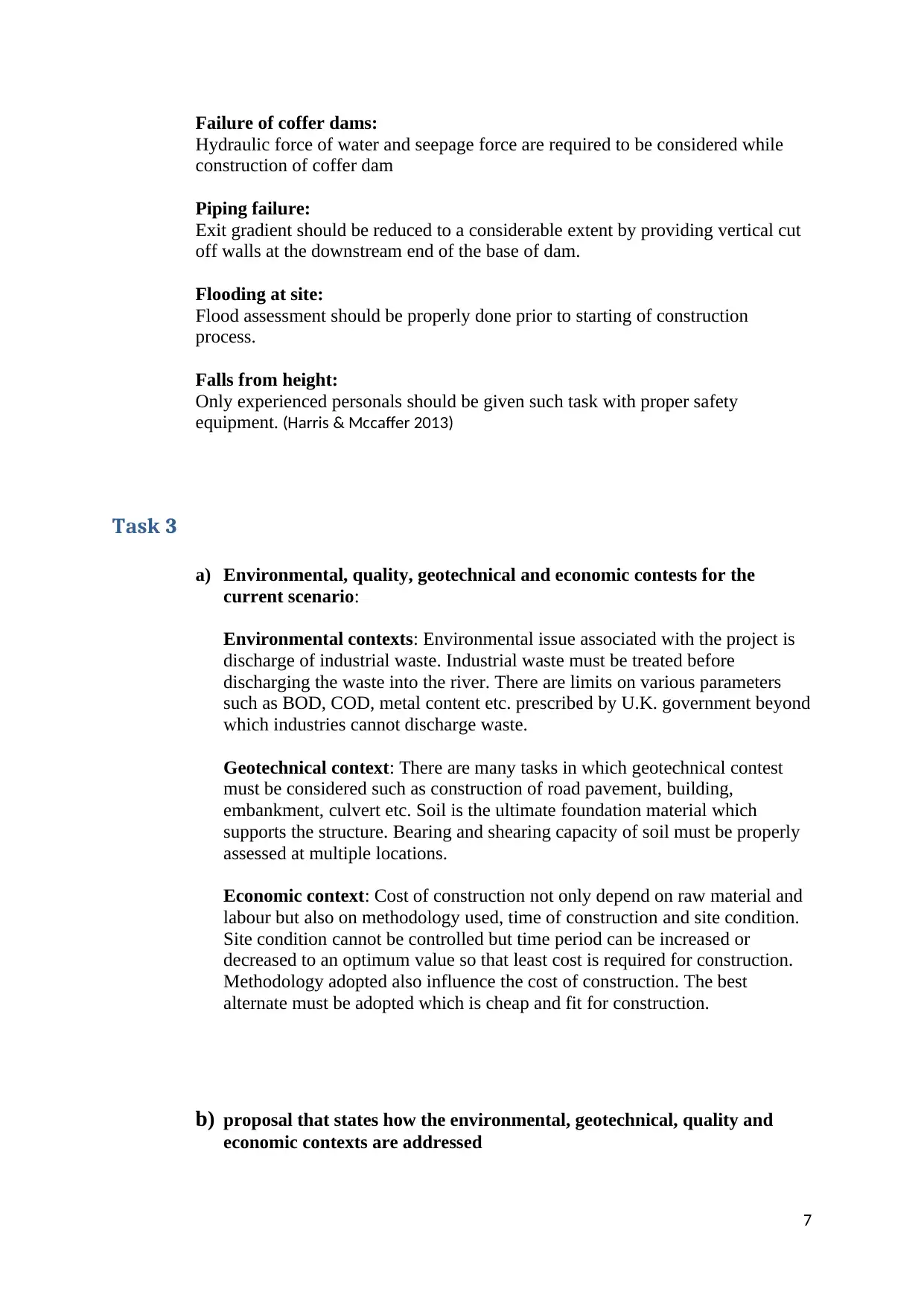
Failure of coffer dams:
Hydraulic force of water and seepage force are required to be considered while
construction of coffer dam
Piping failure:
Exit gradient should be reduced to a considerable extent by providing vertical cut
off walls at the downstream end of the base of dam.
Flooding at site:
Flood assessment should be properly done prior to starting of construction
process.
Falls from height:
Only experienced personals should be given such task with proper safety
equipment. (Harris & Mccaffer 2013)
Task 3
a) Environmental, quality, geotechnical and economic contests for the
current scenario:
Environmental contexts: Environmental issue associated with the project is
discharge of industrial waste. Industrial waste must be treated before
discharging the waste into the river. There are limits on various parameters
such as BOD, COD, metal content etc. prescribed by U.K. government beyond
which industries cannot discharge waste.
Geotechnical context: There are many tasks in which geotechnical contest
must be considered such as construction of road pavement, building,
embankment, culvert etc. Soil is the ultimate foundation material which
supports the structure. Bearing and shearing capacity of soil must be properly
assessed at multiple locations.
Economic context: Cost of construction not only depend on raw material and
labour but also on methodology used, time of construction and site condition.
Site condition cannot be controlled but time period can be increased or
decreased to an optimum value so that least cost is required for construction.
Methodology adopted also influence the cost of construction. The best
alternate must be adopted which is cheap and fit for construction.
b) proposal that states how the environmental, geotechnical, quality and
economic contexts are addressed
7
Hydraulic force of water and seepage force are required to be considered while
construction of coffer dam
Piping failure:
Exit gradient should be reduced to a considerable extent by providing vertical cut
off walls at the downstream end of the base of dam.
Flooding at site:
Flood assessment should be properly done prior to starting of construction
process.
Falls from height:
Only experienced personals should be given such task with proper safety
equipment. (Harris & Mccaffer 2013)
Task 3
a) Environmental, quality, geotechnical and economic contests for the
current scenario:
Environmental contexts: Environmental issue associated with the project is
discharge of industrial waste. Industrial waste must be treated before
discharging the waste into the river. There are limits on various parameters
such as BOD, COD, metal content etc. prescribed by U.K. government beyond
which industries cannot discharge waste.
Geotechnical context: There are many tasks in which geotechnical contest
must be considered such as construction of road pavement, building,
embankment, culvert etc. Soil is the ultimate foundation material which
supports the structure. Bearing and shearing capacity of soil must be properly
assessed at multiple locations.
Economic context: Cost of construction not only depend on raw material and
labour but also on methodology used, time of construction and site condition.
Site condition cannot be controlled but time period can be increased or
decreased to an optimum value so that least cost is required for construction.
Methodology adopted also influence the cost of construction. The best
alternate must be adopted which is cheap and fit for construction.
b) proposal that states how the environmental, geotechnical, quality and
economic contexts are addressed
7
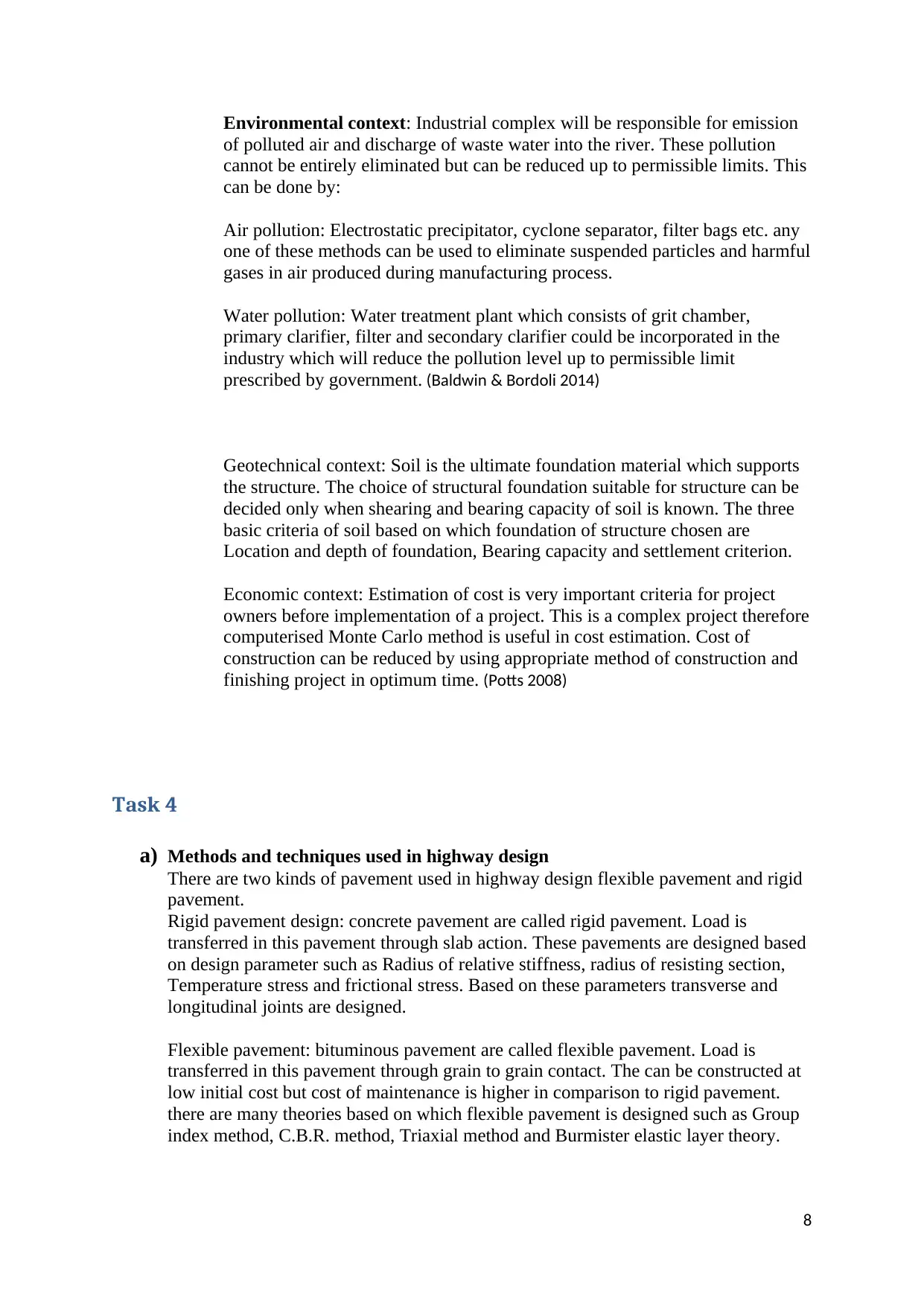
Environmental context: Industrial complex will be responsible for emission
of polluted air and discharge of waste water into the river. These pollution
cannot be entirely eliminated but can be reduced up to permissible limits. This
can be done by:
Air pollution: Electrostatic precipitator, cyclone separator, filter bags etc. any
one of these methods can be used to eliminate suspended particles and harmful
gases in air produced during manufacturing process.
Water pollution: Water treatment plant which consists of grit chamber,
primary clarifier, filter and secondary clarifier could be incorporated in the
industry which will reduce the pollution level up to permissible limit
prescribed by government. (Baldwin & Bordoli 2014)
Geotechnical context: Soil is the ultimate foundation material which supports
the structure. The choice of structural foundation suitable for structure can be
decided only when shearing and bearing capacity of soil is known. The three
basic criteria of soil based on which foundation of structure chosen are
Location and depth of foundation, Bearing capacity and settlement criterion.
Economic context: Estimation of cost is very important criteria for project
owners before implementation of a project. This is a complex project therefore
computerised Monte Carlo method is useful in cost estimation. Cost of
construction can be reduced by using appropriate method of construction and
finishing project in optimum time. (Potts 2008)
Task 4
a) Methods and techniques used in highway design
There are two kinds of pavement used in highway design flexible pavement and rigid
pavement.
Rigid pavement design: concrete pavement are called rigid pavement. Load is
transferred in this pavement through slab action. These pavements are designed based
on design parameter such as Radius of relative stiffness, radius of resisting section,
Temperature stress and frictional stress. Based on these parameters transverse and
longitudinal joints are designed.
Flexible pavement: bituminous pavement are called flexible pavement. Load is
transferred in this pavement through grain to grain contact. The can be constructed at
low initial cost but cost of maintenance is higher in comparison to rigid pavement.
there are many theories based on which flexible pavement is designed such as Group
index method, C.B.R. method, Triaxial method and Burmister elastic layer theory.
8
of polluted air and discharge of waste water into the river. These pollution
cannot be entirely eliminated but can be reduced up to permissible limits. This
can be done by:
Air pollution: Electrostatic precipitator, cyclone separator, filter bags etc. any
one of these methods can be used to eliminate suspended particles and harmful
gases in air produced during manufacturing process.
Water pollution: Water treatment plant which consists of grit chamber,
primary clarifier, filter and secondary clarifier could be incorporated in the
industry which will reduce the pollution level up to permissible limit
prescribed by government. (Baldwin & Bordoli 2014)
Geotechnical context: Soil is the ultimate foundation material which supports
the structure. The choice of structural foundation suitable for structure can be
decided only when shearing and bearing capacity of soil is known. The three
basic criteria of soil based on which foundation of structure chosen are
Location and depth of foundation, Bearing capacity and settlement criterion.
Economic context: Estimation of cost is very important criteria for project
owners before implementation of a project. This is a complex project therefore
computerised Monte Carlo method is useful in cost estimation. Cost of
construction can be reduced by using appropriate method of construction and
finishing project in optimum time. (Potts 2008)
Task 4
a) Methods and techniques used in highway design
There are two kinds of pavement used in highway design flexible pavement and rigid
pavement.
Rigid pavement design: concrete pavement are called rigid pavement. Load is
transferred in this pavement through slab action. These pavements are designed based
on design parameter such as Radius of relative stiffness, radius of resisting section,
Temperature stress and frictional stress. Based on these parameters transverse and
longitudinal joints are designed.
Flexible pavement: bituminous pavement are called flexible pavement. Load is
transferred in this pavement through grain to grain contact. The can be constructed at
low initial cost but cost of maintenance is higher in comparison to rigid pavement.
there are many theories based on which flexible pavement is designed such as Group
index method, C.B.R. method, Triaxial method and Burmister elastic layer theory.
8
⊘ This is a preview!⊘
Do you want full access?
Subscribe today to unlock all pages.

Trusted by 1+ million students worldwide
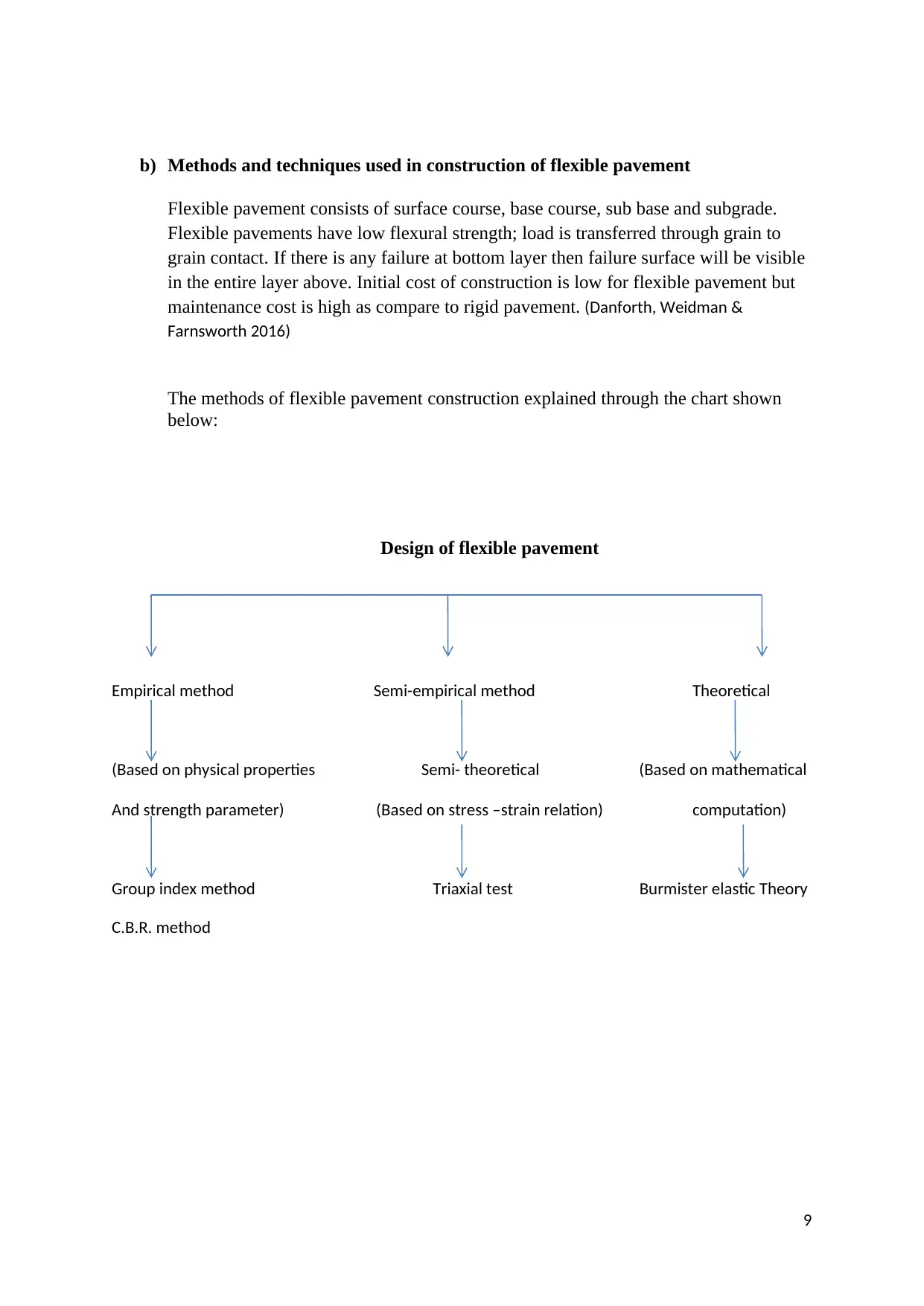
b) Methods and techniques used in construction of flexible pavement
Flexible pavement consists of surface course, base course, sub base and subgrade.
Flexible pavements have low flexural strength; load is transferred through grain to
grain contact. If there is any failure at bottom layer then failure surface will be visible
in the entire layer above. Initial cost of construction is low for flexible pavement but
maintenance cost is high as compare to rigid pavement. (Danforth, Weidman &
Farnsworth 2016)
The methods of flexible pavement construction explained through the chart shown
below:
Design of flexible pavement
Empirical method Semi-empirical method Theoretical
(Based on physical properties Semi- theoretical (Based on mathematical
And strength parameter) (Based on stress –strain relation) computation)
Group index method Triaxial test Burmister elastic Theory
C.B.R. method
9
Flexible pavement consists of surface course, base course, sub base and subgrade.
Flexible pavements have low flexural strength; load is transferred through grain to
grain contact. If there is any failure at bottom layer then failure surface will be visible
in the entire layer above. Initial cost of construction is low for flexible pavement but
maintenance cost is high as compare to rigid pavement. (Danforth, Weidman &
Farnsworth 2016)
The methods of flexible pavement construction explained through the chart shown
below:
Design of flexible pavement
Empirical method Semi-empirical method Theoretical
(Based on physical properties Semi- theoretical (Based on mathematical
And strength parameter) (Based on stress –strain relation) computation)
Group index method Triaxial test Burmister elastic Theory
C.B.R. method
9
Paraphrase This Document
Need a fresh take? Get an instant paraphrase of this document with our AI Paraphraser
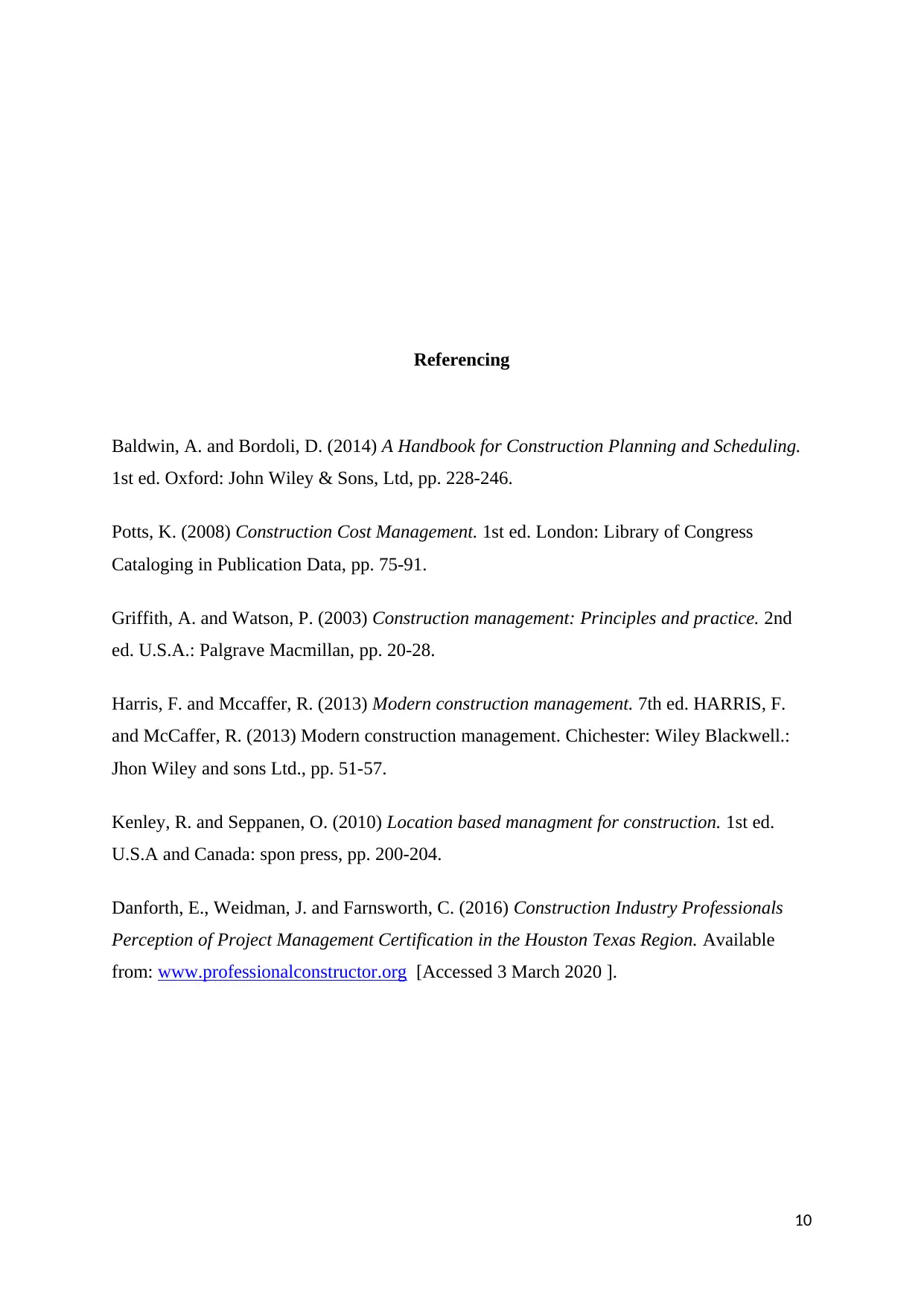
Referencing
Baldwin, A. and Bordoli, D. (2014) A Handbook for Construction Planning and Scheduling.
1st ed. Oxford: John Wiley & Sons, Ltd, pp. 228-246.
Potts, K. (2008) Construction Cost Management. 1st ed. London: Library of Congress
Cataloging in Publication Data, pp. 75-91.
Griffith, A. and Watson, P. (2003) Construction management: Principles and practice. 2nd
ed. U.S.A.: Palgrave Macmillan, pp. 20-28.
Harris, F. and Mccaffer, R. (2013) Modern construction management. 7th ed. HARRIS, F.
and McCaffer, R. (2013) Modern construction management. Chichester: Wiley Blackwell.:
Jhon Wiley and sons Ltd., pp. 51-57.
Kenley, R. and Seppanen, O. (2010) Location based managment for construction. 1st ed.
U.S.A and Canada: spon press, pp. 200-204.
Danforth, E., Weidman, J. and Farnsworth, C. (2016) Construction Industry Professionals
Perception of Project Management Certification in the Houston Texas Region. Available
from: www.professionalconstructor.org [Accessed 3 March 2020 ].
10
Baldwin, A. and Bordoli, D. (2014) A Handbook for Construction Planning and Scheduling.
1st ed. Oxford: John Wiley & Sons, Ltd, pp. 228-246.
Potts, K. (2008) Construction Cost Management. 1st ed. London: Library of Congress
Cataloging in Publication Data, pp. 75-91.
Griffith, A. and Watson, P. (2003) Construction management: Principles and practice. 2nd
ed. U.S.A.: Palgrave Macmillan, pp. 20-28.
Harris, F. and Mccaffer, R. (2013) Modern construction management. 7th ed. HARRIS, F.
and McCaffer, R. (2013) Modern construction management. Chichester: Wiley Blackwell.:
Jhon Wiley and sons Ltd., pp. 51-57.
Kenley, R. and Seppanen, O. (2010) Location based managment for construction. 1st ed.
U.S.A and Canada: spon press, pp. 200-204.
Danforth, E., Weidman, J. and Farnsworth, C. (2016) Construction Industry Professionals
Perception of Project Management Certification in the Houston Texas Region. Available
from: www.professionalconstructor.org [Accessed 3 March 2020 ].
10
1 out of 11
Your All-in-One AI-Powered Toolkit for Academic Success.
+13062052269
info@desklib.com
Available 24*7 on WhatsApp / Email
![[object Object]](/_next/static/media/star-bottom.7253800d.svg)
Unlock your academic potential
Copyright © 2020–2025 A2Z Services. All Rights Reserved. Developed and managed by ZUCOL.
